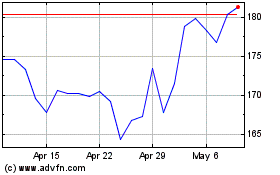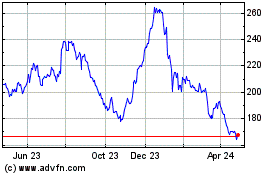By Doug Cameron and Andrew Tangel
Boeing Co. on Wednesday outlined plans to slash more production
and jobs and look for other ways to conserve cash as the
coronavirus pandemic deepens its toll on the global aviation
industry.
The U.S. plane maker lost $2.4 billion in the second quarter and
said it may consolidate some jet assembly among its three main
factories to save money and prepare for a multiyear slowdown in
aircraft deliveries.
Boeing's plans to become smaller will leave the Chicago-based
aerospace giant increasingly reliant on its defense business for
cash and likely ripple through its vast supplier network, their
workforces and the broader U.S. economy.
The worse-than-expected performance in the latest quarter
reflects the impact of the pandemic as well as the prolonged
grounding of the 737 MAX aircraft following two fatal crashes.
Boeing executives said they expected the pandemic's fallout to
continue buffeting the manufacturer through the end of the year,
setting the stage for an eventual recovery to begin taking shape in
2021 if vaccines help control the virus and travel demand rebounds.
They expect travel demand to bounce back in about three years.
"Our industry and our company are weathering challenges like
none we have ever experienced in our lifetimes, and many of those
challenges are still unfolding," Chief Executive David Calhoun said
in a call with analysts Wednesday.
Boeing delivered so few jets in the second quarter that it has
for now lost its mantle as the largest U.S. plane maker to General
Dynamics Corp., whose Gulfstream arm handed over 32 of its high-end
private jets to customers. Boeing managed to deliver 20 jets in the
quarter.
Revenue fell 25% to $11.8 billion. Sales at its defense arm were
flat from a year ago, but they ran four times higher than the
jetliner business and provided a relative bright spot.
Boeing's per-share loss of $4.79 excluding pension costs and
other items compared with a $5.82 deficit a year earlier and the
$2.57 consensus among analysts polled by FactSet. Its results were
weighed down by $2.5 billion in charges to cover airline
compensation for the MAX, severance payments, abnormal production
costs and asset write-offs.
Boeing shares fell 3% in Wednesday afternoon trading. It ended
the quarter with more than $30 billion in liquidity, though its
debt now tops $60 billion.
As Boeing wades through requests from its customers to defer
deliveries or cancel orders for new aircraft, executives said they
were focusing on moving finished aircraft that airlines are
increasingly reluctant to take or unable to afford.
Future production increases would depend on how quickly Boeing
can move its growing inventory of finished airplanes, sometimes to
new buyers they weren't originally designed for.
The company has restarted limited MAX production, but pushed
back an increase to 31 planes a month until 2022. Boeing is also
trimming monthly output of its 787 Dreamliner to six and its 777
wide-body to two.
The revamped 777X plane that Boeing is relying on to generate
cash won't arrive until 2022, two years behind schedule, and Boeing
said it would stop making its 747 jumbo in 2022.
Boeing said it would further reduce its head count by an
unspecified number beyond the 19,000 cuts it currently expects. The
company previously announced plans to shrink its 160,000-strong
workforce by about 10%, with most of those layoffs coming from its
beleaguered commercial arm.
Chief Financial Officer Greg Smith said the company would reduce
jetliner production faster, but took into consideration the
stability of its supply chain and production operations.
Mr. Calhoun said the plane maker is studying whether to
consolidate 787 Dreamliner production, rather than making the jets
at two factories in Everett, Wash., and North Charleston, S.C. He
said it was too soon to predict what any changes could mean for
those sites.
Global airline traffic is forecast to fall more than 60% this
year because of travel restrictions and weakening economic growth,
and take until 2024 to recover to its 2019 level after a decade of
rapid growth, according to the International Air Transport
Association, a trade group.
Airlines and leasing companies have responded by canceling and
deferring aircraft orders, forcing Boeing and rival Airbus SE to
reduce production, prompting suppliers to follow suit and cut
thousands of jobs. Airbus is due to report second-quarter earnings
on Thursday.
The slump in deliveries to 20 jets in the latest quarter
worsened Boeing's cash drain. The company burned through $5.6
billion in cash during the June quarter. Boeing raised $25 billion
in debt during the quarter and had $61.4 billion in debt at the end
of June. Mr. Smith said Boeing expects to resume generating cash
next year.
The latest quarter reflects temporary shutdowns of various
factories as infections among Boeing workers mounted in the spring
and suppliers faced their own constraints.
Boeing's office employees will likely continue working from home
until early next year, longer than previously planned. "We're going
much more slowly," Mr. Calhoun told reporters Wednesday.
In April, Boeing announced it would ramp up MAX production to 31
jets a month next year, almost half the level before that
aircraft's grounding in March 2019 following the crashes that took
346 lives.
As the MAX's production ramp-up faces delays, so do the
aircraft's expected regulatory approvals to resume commercial
service. Boeing said it now expects to resume MAX deliveries in the
fourth quarter, rather than its previous estimate of the third
quarter.
Mr. Calhoun said the pandemic has resulted in logistical hurdles
that have further delayed the aircraft's certification.
Write to Doug Cameron at doug.cameron@wsj.com and Andrew Tangel
at Andrew.Tangel@wsj.com
(END) Dow Jones Newswires
July 29, 2020 16:12 ET (20:12 GMT)
Copyright (c) 2020 Dow Jones & Company, Inc.
Boeing (NYSE:BA)
Historical Stock Chart
From Mar 2024 to Apr 2024

Boeing (NYSE:BA)
Historical Stock Chart
From Apr 2023 to Apr 2024
